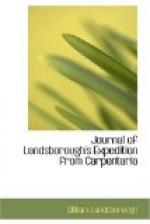March 21.
Fisherman and I left camp this morning and went south-east for fourteen miles. The first four miles took us over the range to the head of a creek, the next five miles down the creek, and the next five miles to the left of the creek. We then went south-west to the creek and selected a place for the next encampment. Then, returning to depot camp, we followed up the creek, and it took us in a north half west direction for five miles to our outward tracks. Then, returning by our track to camp, we reached it by travelling for an hour after dark. In going and returning we spent nearly twelve hours on horseback. At camp I was sorry to learn that Gleeson was still very unwell. The country on the other side of the range is nearly level; back from the creek it is chiefly overgrown with triodia and wooded with ironbark. The ironbark-trees are the first I have seen on this expedition. Near the creek and at some places for a mile back from it the soil is rich with luxuriant good grass, except at places where it is thickly wooded with western-wood acacia and Port Curtis sandalwood where the herbage is not so rank, but the saltbush amongst it is a good sign of its having the most fattening qualities. The ranges on the southern side of the valley are not so good as the ranges on the northern side, the former are more sandy and are not so well covered with rich basaltic soil.
March 22. Camp 31, situated on the right bank of Jardine Creek at a point about five miles above its junction with Flinders River.




